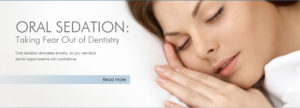YOU NO LONGER HAVE TO SUFFER FROM “DENTAL ANXIETY”
Types of Sedation Offered in Our Office: 
NOW OFFERED IN OUR OFFICE!
Nitrous Oxide or Inhalation Sedation: (Laughing Gas): 
Inhalation sedation, laughing gas, relative analgesia, happy gas, nitrous, nitrous oxide, or N2O-O2 is a few of the names generally used for this type of sedation… this one has more names than any other sedation technique! And deservedly so. Inhalation sedation with nitrous oxide (N2O) and oxygen (O2) has been described as “representing the most nearly ‘ideal’ clinical sedative circumstance”…
Nitrous oxide (N2O) is simply a gas which you can breathe in. It has no color, or smell, and doesn’t irritate. It was discovered in 1772. Humphrey Davy (1778-1829), one of the pioneers of N2O experimentation. Nitrous oxide works while it is been inhaled. Once the gas is removed the effects of this sedation go away.
Depending on the concentration and length of administration of laughing gas, the following levels of sedation can be experienced
- an initial feeling of light-headedness
- a tingling sensation, especially in the arms and legs, quickly followed by
- warm sensations, and
- a feeling of well-being, euphoria and/or floating
In other words nitrous oxide makes you feel as though you had a few glasses of wine. Happy and euphoric!
Advantages of Nitrous Oxide Sedation (Laughing Gas)
- The depth of sedation can be altered at any time to increase or decrease sedation.
- There is no after effect such as a “hangover”
- Inhalation sedation is safe with no side effects
- Inhalation sedation is effective in minimizing gagging
- It works rapidly as it reaches the brain within 20 seconds
- In as few as 2-3 minutes its relaxation and pain killing properties develop.
- Mild pain control
- No prior arrangements needed.
- You may drive after procedure is done
Contraindication of Nitrous Oxide Sedation (Laughing Gas)
- Though there are no major contraindications to using nitrous oxide, you may not want to use it if you have emphysema, exotic chest problems, M.S., a cold or other difficulties with breathing.
Disadvantages Nitrous Oxide Sedation (Laughing Gas).
- Mild pain control (may not be enough)
- Mild sedation (may not be enough)
- Reversible (no residual sedation for post op pain control)
Nitrous Oxide Sedation (Laughing Gas) is best for
- Mildly fearful patients.
- To help “pass the time” of treatment .
- Short / easy procedures.
- When cost is a factor
- When a ride home is not available
Oral Sedation: 
Oral sedation means taking tablet or capsule by mouth. Usually you have to have someone pick you up after the appointment. You cannot drive a car or use heavy machinery for 24 hours. Usually you take the tablet 1-2 hours before your dental treatment to allow it to work.
Follow the guidelines of the dentist and arrange for someone to drive you home. You will notice that you are very sleepy and will stay in this state for a few hours.
Try not to go back to work until the next day.
Impacts of Oral Sedation:
This medicine slows down your senses so you will have decreased reactions to pain, smells and sounds. They additionally cause a gentle type of amnesia so you may not recollect any details about your treatment.
In the event that you are taking any medicine please let us know before we give you this sedative. In addition, let us know if you are allergic to a specific kind of medicine. Oral sedation is not for all patients.
Advantages of oral sedation
- Mild to moderate pain control
- Not reversible (comfortable ride home)
Disadvantages of oral sedation
- Mild to moderate pain control / sedation (may not be enough)
- Difficult to control the level of sedation achieved
- Prior arrangements essential (empty stomach & ride home require)
- Patient must be in fair to good overall health
Oral sedation is best for
- Patients with mild anxiety.
- As a “pre-medication” before intravenous sedation
- To help “pass the time” of treatment
- Short and easy procedures.
- When cost is a factor
- When predictable sedation is not essential


